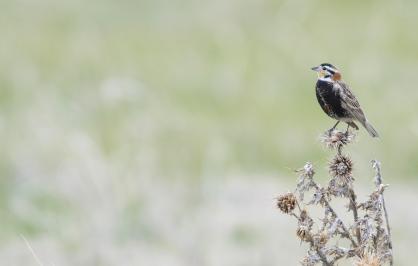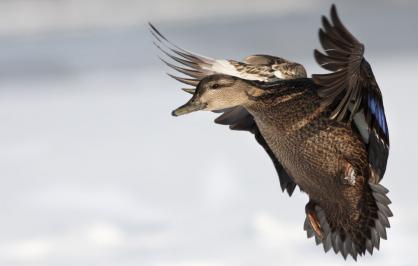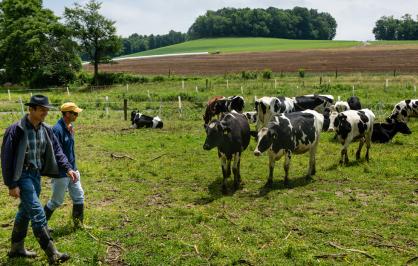The nation’s agricultural producers are stewards of some of the most productive habitats for native birds, fish, reptiles, amphibians, mammals and pollinators that live on or move across agricultural lands.

Conservation and agriculture
2020 Conservation Highlights
America asks a lot of its farmers and ranchers. Not only must they feed the 330 million people who live in this country, but they also must run successful businesses and compete on a global scale.
The nation’s agricultural producers have yet another challenge, one that most grocery store shoppers and restaurant diners might never consider. These private citizens serve as stewards of some of the most productive habitats for America’s wildlife. The native birds, fish, reptiles, amphibians, mammals and pollinators that live on or move across agricultural lands are a public resource. We all depend on our agricultural producers’ good stewardship of these lands and waters to help sustain our nation’s wildlife populations for current and future generations.

Those who produce America’s fruits, vegetables, grains, textiles, and meat and dairy products feel a close connection to the lands they work, the waters upon which they depend, and the wildlife they see every day. They also value productivity and successful business practices. Fortunately, the pursuit of efficiency on working lands often goes hand-in-hand with conserving wildlife habitat, whether that is through the management of invasive species, more efficient irrigation and fertilization, or better stormwater management. This is where NFWF and its many conservation partners come in.
The Foundation excels at helping agricultural producers strengthen their operations and attain voluntary conservation goals that they, themselves, are eager to achieve. Our grantees specialize in offering practical, site-specific guidance and innovative financial incentives for agricultural producers to make operational improvements that benefit wildlife and improve soil health and water quality — without endangering their bottom lines.
To achieve this, NFWF builds partnerships that unite agricultural stakeholders, including major food and beverage corporations seeking advancements in sustainability, federal agencies such as the U.S. Department of Agriculture’s Natural Resources Conservation Service, nonprofit organizations such as Margaret A. Cargill Philanthropies, conservation districts, commodity associations and, of course, individual farmers and ranchers across the country.
Conservation on farms
Farmers, conservation groups, government agencies and food and beverage companies share many common goals, chief among them clean, abundant water supplies and healthy, productive soils. Nobody wants farmers to waste money on fertilizer that washes off their fields into freshwater streams, where excess nutrients degrade habitats and imperil wildlife populations. NFWF invests in projects that drive innovation and produce win-win scenarios for all agricultural stakeholders. Many projects supported by NFWF help willing farmers implement no-till cover cropping, invest in new manure injection technologies, restore pocket wetlands to catch runoff, and plant forested buffer zones. Examples of our 2020 grant-making include:
NFWF awarded a grant of $600,000 to the American Farmland Trust to offer one-on-one technical assistance to farmers and build holistic soil health management systems on farms in three counties in Ohio.
A $489,000 grant to the Alliance for the Chesapeake Bay will enable farmers in Maryland to establish forested buffers between fields and streams to benefit Chesapeake logperch, a small, ray-finned fish that only exists in a relatively small area in the Susquehanna River basin.
The Illinois Corn Growers Association won a $258,000 grant to work field-by-field in parts of Illinois and Kentucky helping farmers improve efficiency and prevent excess nutrients and sediment from fouling waterways.

The Vermont Land Trust will use a $199,000 grant to produce ecological assessments and wetland restoration plans for 12 farmland conservation projects that will prevent excess fertilizer from entering the Connecticut River and flowing downstream to Long Island Sound.
In Michigan, the Clinton Conservation District will leverage a $183,000 grant to increase farmer participation in federal Farm Bill programs by working with landowners to create and put into practice conservation management plans.
Healthier grasslands for cattle and wildlife
Successful cattle operations depend on healthy rangelands. High-quality grasslands are not just great for cattle — pronghorn, deer, elk, grouse and a wide variety of other wildlife thrive on America’s cattle ranches. NFWF, its funding partners and its grantees all recognize the value of working landscapes, for both wildlife and rural vitality. Grants awarded in 2020 helped protect ranches from being broken up and developed, fought the spread of invasive species that increase the risk of wildfire, and modified fencing to reduce the risk of injury to birds and big game living on or moving through ranches. Examples of our 2020 grant-making include:
In Colorado, the Rocky Mountain Bird Observatory will use a $200,000 grant to increase rancher enrollment in Farm Bill conservation programs and improve management of 10,100 acres.
In Montana, the Ranchers Stewardship Alliance will use a $299,000 grant to offer technical support to ranchers across four counties, improving management on 5,700 acres of grassland habitat and maintaining a high-quality grazing landscape.
Watch: Across the West, NFWF is working with ranchers, federal and state partners, and other non-profit organizations to support conservation on working lands.
In Nebraska, the Sandhills Task Force will use a $300,000 grant to improve grassland habitat on private land by controlling eastern red cedar infestations and improving grazing systems.
In South Dakota, the American Bird Conservancy will use a $189,000 grant to provide conservation technical assistance, develop conservation plans, and assist private landowners in enrolling in Farm Bill programs.
Helping dairy farmers improve practices
Over the past 35 years, NFWF has built deep partnership networks within the dairy-producing communities of the Chesapeake Bay and Great Lakes watersheds, awarding hundreds of grants to help boost efficiency on dairy farms and improve water quality. NFWF continues to build on these successes while putting these proven strategies to work throughout the nation. Examples include:
A grant of $990,000 will enable the Mid-Atlantic 4R Nutrient Stewardship Association to engage 300 farms to implement nutrient management and complete a pilot project for a manure transport exchange in Delaware, Maryland, Pennsylvania and Virginia.
Sustainable Environmental Consultants will use a grant of $183,000 to accelerate implementation of innovative soil health practices and improve profitability on farms within a dairy supply chain in Iowa and five other states.
Pheasants Forever will use a $252,000 grant to deploy a conservation specialist to accelerate the adoption of economically beneficial, on-farm conservation practices in Ohio.
Want to learn more? Explore an interactive map of where we work.

Next Highlight: Coral Reef Conservation
In 2020, NFWF and NOAA celebrated 20 years of partnership to restore and enhance coral reefs.
Learn More














